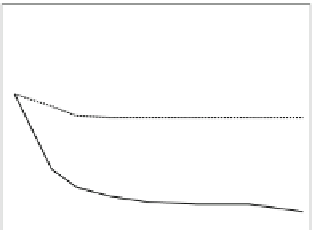Information Technology Reference
In-Depth Information
Network radius (R = 50 m)
Network radius (R = 50 m)
R 2R 2.5R 3R 3.5R 4R 4.5R 5R
R 2R 2.5R 3R 3.5R
4
R 4.5R 5R
43
42.8
First node battery run out SA−MAC
10% nodes battery run out SA−MAC
30% nodes battery run out SA−MAC
First node battery run out SA−MAC+NORIA
10% nodes battery run out SA−MAC+NORIA
30% nodes battery run out SA−MAC+NORIA
First node battery run out SA−MAC
10% nodes battery run out SA−MAC
30% nodes battery run out SA−MAC
First node battery run out SA−MAC+NORIA
10% nodes battery run out SA−MAC+NORIA
30% nodes battery run out SA−MAC+NORIA
42.7
42.8
42.6
42.5
42.6
42.4
42.4
42.3
42.2
42.2
42.1
42
42
41.9
41.8
41.8
21
81
121
177
241
317
401
489
21
81
121
177
241
317
401
489
Number of nodes
Number of nodes
(a) Irregular topology.
(b) Grid topology.
Fig. 4.
Network lifetime
to consider circular network areas with constant node density. The network size
varies from 50 to 250m, and the number of nodes varies from 21 to 489. We have
used both grid and irregular topologies for the purpose of experimenting with
different node deployments. The experiments have been executed 100 times in
order to obtain reliable results.
Figure 3 shows that the addition of fuzzy logic only increments the set-up
time when we are working with the grid topology, due to the fact that the nodes
are frequently changing for a best parent, compared to the original SA-MAC
way of working.
The lifetime of the network, in general terms, is improved. For both cases, grid
and irregular, (see Fig. 4), the time in which the first node's battery run out
is improved, and the gap between this event and 10% and 30% of the network
lifetime is reduced, indicating that network workload has been balanced correctly
in the continuous process of network re-configuration. What is noteworthy is the
improvement on grid topology. Although the set-up time was slightly longer,
this increase is not significant compared to the balance of workload among the
nodes, and so the network lifetime significantly increased.
7 Conclusions
In this paper, we have integrated an existing TDMA-based MAC protocol with
NORIA, an intelligent routing approach for WSNs.
Since the correct operation of a wireless sensor network requires that all nodes
have to know who they have to send to, and at which moment, it is desirable
that the network is both self-organized and synchronized. First of all, we have
performed a deep study of previous work, and SA-MAC was selected to be
integrated with a fuzzy-logic-based routing algorithm, NORIA.
Experimental results have shown that the combination of SA-MAC and NO-
RIA reduces the depth of the communication tree, and that the network load
has been balanced among nodes,thus increasing network lifetime.





































































































































































































































Search WWH ::

Custom Search